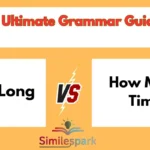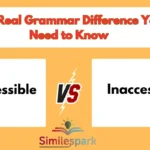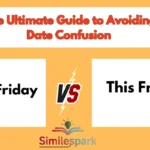Have you ever heard someone say “That’s mean!” and another say “That means…”, and wondered why they sound so similar yet mean completely different things?
You’re not alone. English learners often confuse these phrases because they look and sound alike — only a tiny apostrophe and letter separate them, yet their meanings are worlds apart.
In this guide, you’ll finally understand the real difference between “That’s mean” and “That means,” how to use each one naturally, and how to avoid common mistakes.
You’ll see examples, comparison tables, pronunciation tips, and even a fun quiz to test your understanding.
Let’s clear this up once and for all.
Understanding the Core Difference Between “That’s Mean” and “That Means”
Here’s the simple truth:
- “That’s mean” talks about someone’s behavior or attitude — it’s emotional.
- “That means” talks about an explanation or result — it’s logical.
Think of it this way:
| Phrase | Function | Meaning | Example |
|---|---|---|---|
| That’s mean | Describes a person’s behavior | Unkind, rude, unfair | “That’s mean! Don’t make fun of him.” |
| That means | Explains a result or definition | Clarifies, indicates | “That means we’re going to be late.” |
👉 Quick rule:
If you’re talking about feelings, use That’s mean.
If you’re talking about meaning or explanation, use That means.
Deep Dive: What “That’s Mean” Really Means
Definition and Function
“That’s mean” is a contraction of “That is mean.” It’s used to describe something unkind, unfair, or hurtful.
You’ll often hear it in conversations where someone disapproves of another person’s words or actions.
Example:
“You hid her phone? That’s mean!”
The word “mean” here refers to cruel behavior or intention.
Emotional and Social Nuance
The phrase carries strong emotional weight. It’s not about explaining something — it’s about reacting to it.
It can express:
- Disapproval — when someone behaves badly.
- Empathy — when someone’s feelings are hurt.
- Sarcasm or teasing — in playful situations.
Example:
“You ate the last slice of pizza? That’s mean!” (said jokingly)
So, tone is key. The same phrase can sound serious or funny depending on how you say it.
Common Situations Where “That’s Mean” Is Used
You’ll hear “That’s mean” in casual conversations, especially among friends, kids, or family.
| Situation | Example |
|---|---|
| Scolding someone | “Don’t laugh at him — that’s mean!” |
| Expressing sympathy | “They ignored you? That’s mean.” |
| Sarcastic joke | “You scared me on purpose? That’s mean but funny!” |
Alternatives to “That’s Mean”
Sometimes, “mean” isn’t quite the right fit. Try these instead:
| Alternative | Meaning | Example |
|---|---|---|
| That’s rude | Impolite or disrespectful | “Interrupting is rude.” |
| That’s harsh | Too strong or critical | “Calling him lazy was harsh.” |
| That’s unkind | Lacks compassion | “Not helping her was unkind.” |
| That’s cruel | Intentionally hurtful | “That prank was cruel.” |
Pro tip:
“Mean” is mild compared to “cruel” or “harsh.” It’s suitable for everyday use without sounding too serious.
Cultural Note: British vs American Usage
In American English, “mean” usually means “unkind.”
But in British English, “mean” can also mean “stingy” — someone who doesn’t like to spend money.
Example (British):
“He never buys coffee for anyone. He’s so mean!”
So, be mindful of where you’re speaking — context is everything.
Deep Dive: What “That Means” Really Means
Definition and Function
“That means” is short for “That signifies” or “That indicates.”
It’s used to explain, define, or clarify something — perfect for giving logical or factual information.
Example:
“It’s cloudy. That means it might rain.”
Here, “That means” connects two ideas logically — clouds → possible rain.
Everyday Uses of “That Means”
You’ll hear this phrase in both everyday conversation and formal explanations. It’s versatile and fits almost anywhere.
| Situation | Example |
|---|---|
| Drawing a conclusion | “He’s not answering. That means he’s busy.” |
| Giving instructions | “The red light is on. That means it’s charging.” |
| Explaining definitions | “A synonym means a word with a similar meaning.” |
| Logical reasoning | “That means we’ll need to leave early.” |
Signal Words That Often Follow “That Means”
“That means” is often followed by connecting words or clauses. Common ones include:
- That means that… “That means that we’re done for the day.”
- That means we should… “That means we should hurry.”
- That means you’re… “That means you’re officially promoted!”
Pronunciation and Grammar Notes
Both sound similar, but pay attention to the ending sound.
| Phrase | Phonetic | Ending Sound |
|---|---|---|
| That’s mean | /ðæts miːn/ | Ends with “s” sound |
| That means | /ðæt miːnz/ | Ends with “nz” sound |
Practice saying them aloud:
“That’s mean.” (short, sharp)
“That means.” (smooth, ending in ‘z’)
That small sound difference can completely change the meaning.
Examples in Real Sentences
“That’s Mean” Examples
- “You called her names — that’s mean.”
- “Don’t ignore your friend. That’s mean.”
- “That’s mean! You scared me on purpose.”
“That Means” Examples
- “The door’s locked. That means no one’s home.”
- “He didn’t reply. That means he’s not interested.”
- “It’s raining — that means the game’s canceled.”
Comparison in Real Conversations
Here’s a short dialogue to show the contrast:
A: “You laughed when she tripped?”
B: “That’s mean!”
A: “Oh, sorry. I didn’t realize that means I hurt her feelings.”
See how “That’s mean” is about emotion and “That means” is about explanation?
They sound similar but function completely differently.
Common Mistakes and Why They Happen
Frequent Errors
- Saying “That means!” when they really mean “That’s mean!”
- Forgetting the apostrophe in writing.
- Mishearing the difference in spoken English.
Why Mistakes Occur
- Both use “that + verb” structure.
- They sound almost identical in fast speech.
- Many languages don’t separate emotional vs logical expressions the same way English does.
To fix this, slow down when you speak and listen for the -s or -nz ending.
Quick Fixes and Usage Hacks
Simple Decision Guide
Here’s a quick way to decide which to use:
| Ask Yourself | If Yes → Use |
|---|---|
| Am I describing someone’s behavior or attitude? | That’s mean |
| Am I explaining what something indicates or means? | That means |
Mnemonic Device
To remember easily:
- Mean → Mean person (emotion)
- Means → Meaning (definition)
So, if there’s emotion, it’s That’s mean.
If there’s explanation, it’s That means.
Visual Trick
Picture this:
| Word | Image | Reminder |
|---|---|---|
| Mean | 😠 | Describes emotion or rudeness |
| Means | 💬 | Explains something or gives meaning |
Similar and Related Phrases
Alternatives to “That’s Mean”
- “That’s rude.”
- “That’s harsh.”
- “That’s cruel.”
- “That’s not nice.”
- “That’s unfair.”
Alternatives to “That Means”
- “In other words…”
- “So…”
- “That indicates…”
- “Which implies…”
- “It suggests that…”
These alternatives can make your speech sound more natural and flexible.
Real-Life Case Study: “That’s Mean” vs “That Means” in Context
Let’s analyze a real conversation example.
Scenario:
Two coworkers talking at lunch.
Sam: “Did you hear? The manager canceled Friday’s lunch.”
Alex: “That’s mean! We were all looking forward to it.”
Sam: “Yeah, but that means we’ll save some money this week.”
Here’s what’s happening:
- That’s mean = emotional reaction (disappointment).
- That means = logical explanation (financial benefit).
This case shows how the same conversation can use both phrases — each serving a completely different purpose.
Quick Recap Table
| Context | Correct Phrase | Example |
|---|---|---|
| Talking about behavior | That’s mean | “It’s mean to tease people.” |
| Explaining a meaning | That means | “That means you should stop teasing.” |
🙋 Frequently Asked Questions (FAQs)
What does “That’s mean” mean?
It means someone’s words or actions are unkind or rude. For example, “That’s mean to laugh at others.”
What does “That means” mean?
It’s used to explain or clarify something. Example: “It’s raining — that means the picnic is canceled.”
Is “That’s mean” always negative?
Usually, yes. But tone can change it — sometimes it’s playfully sarcastic, like “You stole my fries? That’s mean!”
How can I remember the difference easily?
Use this tip:
If it’s about feelings, say “That’s mean.”
If it’s about logic or result, say “That means.”
Why do English learners confuse these phrases?
Because they sound similar and both use “that’s/that.” The “s” and “nz” sounds are subtle, making them easy to mix up in fast speech.
Conclusion
Now you know:
- “That’s mean” expresses emotion or judgment about behavior.
- “That means” gives information or explanation about a fact.
They might sound almost the same, but context makes all the difference.
Next time you’re speaking English, pause for a second — are you reacting emotionally or explaining logically? That quick check will help you choose the right one every time.
Practice by writing five sentences using each phrase, or listen to how native speakers use them in movies and podcasts. With a bit of repetition, you’ll never mix them up again.
🧩 Bonus Mini Quiz
Pick the correct phrase for each:
- “You took my seat! ___” → That’s mean
- “It’s 9 p.m. already. ___ we missed the bus.” → That means
- “She ignored your text? ___” → That’s mean
- “It’s raining. ___ the party is canceled.” → That means
- “You scared me on purpose! ___” → That’s mean










